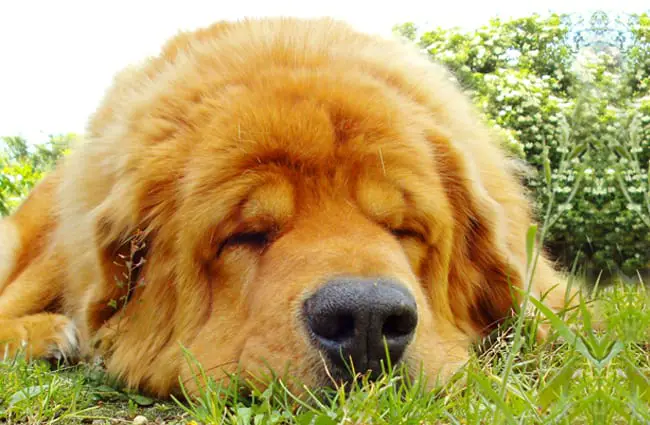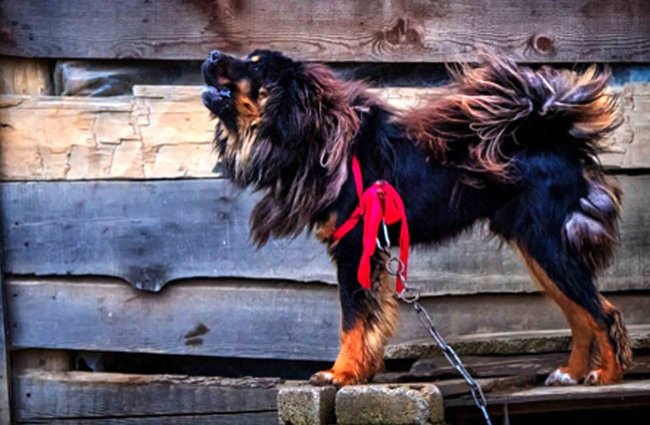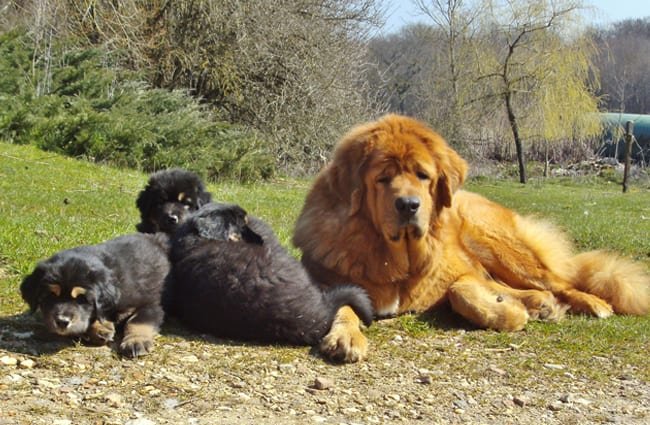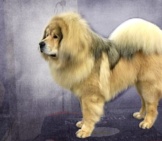The Tibetan Mastiff is a gargantuan creature that more resembles a lion than a traditional pet dog. Yet these huge, surprisingly graceful, creatures have a lengthy history. In fact, they may be some of the first known Mastiffs to ever be bred. They make lovely hearth warmers: gentle and laid back with family, but often territorial with others. However, they can be quite a lot of dog to handle. Read on to learn more about the Tibetan Mastiff.
Description of the Tibetan Mastiff
These dogs are huge – there’s no way around it. They’re made more impressive by their copious amounts of hair. It falls particularly impressively around their necks, giving many of these Mastiffs the impression of a mane. This crest often also obscures their distinctive, v-shaped ears.
The Tibetan Mastiff should not be defined by his size, though. Bred as a protector, this breed is always ready to jump into action. They are surprisingly agile. Most of the time, these dogs enjoy simply lazing around the house.
The breed is quite striking, with their excess amount of hair. They come in a variety of colors, running the gamut from black to tan.
Life Expectancy and Size
For being such a large dog, the Tibetan Mastiff has a relatively lengthy life expectancy. They generally live into the double digits. Most live to be between 10 and 12 years old.
Female Tibetans stand 24 inches or taller at the shoulder, while males stand at least 26 inches. The breed weighs between 70 and a whopping 150 pounds. Of course, the males tend to be at the higher end of this spectrum, while females are at the lower end.
This breed is not technically a giant breed, but tests the limit of what we think of as a large dog.
Protective Ability
Protecting is what the Tibetan Mastiff was born to do – they were bred to care for both flock and family. Their best line of defense is their impressive looks. An intruder would have to be very bold to challenge a property that belonged to a Tibetan.
While they tend to be a deterrent, these dogs are not overly aggressive, especially if adequately socialized. They’ll often make their presence known, and have an impressively deep bark that they don’t hesitate using at night. If absolutely necessary, most Tibetan Mastiffs will jump into action, as they are incredibly loyal.
Training
Training such a beast is, well, difficult. These dogs are not a walk in the park to deal with, and are not recommended for the first time dog owner.
It is extremely important to build a working and trusting relationship with the Tibetan Mastiff. This is usually derived by maintaining calm, using rewards, and being almost painfully consistent. Attempting to force a dog this large into doing something simply won’t go over well. You’ll be better served to leverage what your dog wants to reward him for good behavior.
The Mastiff is a smart breed that can quickly become bored. Short training sessions are advised. Unfortunately, treats and other food rewards do little to sway these dogs. They tend to be unmotivated by food. Some regularly even skip whole meals. This means that creativity – not force – in training is essential.
Energy Level
This breed has a medium energy level. Most of the time, they don’t want to expend the energy to move their massive bodies more than a few inches. However, occasionally they will jump into action and expose themselves as surprisingly agile.
Their energy is usually directed toward work, which they often consider to be protecting the household. For this reason, the Tibetan Mastiff is more likely to be found patrolling the perimeter than playing typical dog games, which this proud breed seems to consider too silly.
What Living with a Tibetan Mastiff is Like
This dog is not for the faint of heart, as they were bred to be working dogs and not pets. At times, they can be austere and hard to manage, and certainly do not like to play like many other breeds. Add to this the difficulties that come with caring for such a large breed, and you get a dog that is simply too much to handle for most people.
That does not mean that the Tibetan cannot be a lovely companion for those that are prepared. These dogs are sweet, and often extremely loyal to their humans. Gentle giants, most Mastiffs are sweet with their family’s kids as well.
However, socialization is always important with this breed. Their territorial nature means that Tibetan Mastiffs that haven’t been adequately exposed to new environments and people can become aggressive. Even with socialization, they often work best in single dog households.
Health can also be an issue for these dogs, and grooming a challenge.
Care of the Tibetan Mastiff
Caring for the Tibetan Mastiff is not easy, despite their usually laissez-faire personality. Owners must be dedicated to maintaining such a large, work-minded breed.
Environmental Needs
These dogs were bred for the harsh environments of the Himalayas. This, of course, means that they will be just fine in extreme environments. However, they are large dogs with lots of hair.
Very warm climates can be hard on their systems. In fact, these Mastiffs are usually noticeably more active in the colder months. They are rugged dogs that enjoy the outdoors, so extremely hot homes are not advised. As always, make sure to provide these dogs with shade and water at all times.
Exercise Needs
This breed does best with a large, enclosed yard – but with a sturdy fence, not a buried electronic system. It’s also important to avoid letting your giant mastiff terrorize the neighbors by barking and charging at them through the fence. For this reason, it’s generally best not to leave them outside unattended in urban areas.
They are very independent in their exercise needs, and prefer to patrol their territory at their own pace. Although they are not low energy, their excitement comes and goes in quick snippets. They prefer to be able to direct their movements themselves, rather than be forced into some kind of routine. Many Tibetan Mastiffs do appreciate the occasional walk with their owner, though.
These dogs generally think they’re above play. They also don’t make great running or intense hiking partners, because their endurance is fairly low.
Shedding and Grooming
The Tibetan Mastiff sheds a lot. They may go through one or two periods a year where this shedding becomes even more profuse. During this time period, it is important to remove excess hair that gets stuck under their outer coat.
At other times of the year, at least weekly brushing will help their hair avoid matting. Only occasional baths are needed, when they get into something particularly smelly.
Ideal Home Environment
This breed is only suitable for a competent and skilled owner that can take on their large personality and physique.
They do best in one-dog homes, but many Tibetans do enjoy having children around. Families should be loving, but not eager to play or share in games and activities. The Tibetan Mastiff makes a loving protector, not a plaything.
Owners must understand the importance of obedience and socialization. Otherwise, this breed can become a handful, potentially even dangerous.
Health Concerns
This breed is not unhealthy, especially for such a large breed. However, they do face some specific concerns.
These dogs are prone to hip and elbow issues and, although they do not generally crave exertion, it is important to keep them from hurting themselves, especially when young.
Other issues arise with the eyes and thyroid. There are some cases of seizures in the breed, but they aren’t overly common.
Behavior Problems
This breed is quite independent. Sometimes this means that they just will not seem to listen. Starting obedience and socialization classes early can help the Tibetan become the best dog he can be. Of course, discuss any serious issues with a behavioral specialist.
Given their history as a guard dog, Tibetan Mastiffs may also become highly suspicious of strange people and strange dogs. Even if this suspicion doesn’t lead to aggression, these dogs are scary enough that suspicion is a problem! Prevent this with good socialization, and treat it with the help of a behavior consultant.
These dogs can also jump surprisingly high. With anything less than a six-foot fence, you may find them protecting the family from outside the yard!


























![Red Angus Closeup of a beautiful Red Angus cowPhoto by: U.S. Department of Agriculture [pubic domain]https://creativecommons.org/licenses/by/2.0/](https://animals.net/wp-content/uploads/2020/03/Red-Angus-4-100x75.jpg)

